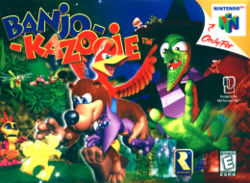Banjo-Kazooie

| |
| Banjo-Kazooie | |
| Developer | Rare Ltd. |
| Publisher | Nintendo |
| System | Nintendo 64 |
| Release Date | Nintendo 64 US May 31, 1998 EU July 17, 1998 JP December 6, 1998 |
| Rating | ESRB: E |
Banjo-Kazooie is an action-adventure game by Rare. The game began development under the name Dream on the Super Nintendo. The game was to feature a boy named Edison who got into trouble with some pirates. The hero became a rabbit, a dog, and eventually a bear.
Banjo-Kazooie was heavily marketed, touted as being to the Nintendo 64 what Donkey Kong Country was to the Super Nintendo in terms of graphics. It was set to be the must-have game of Christmas 1997, but was pushed back due to development issues. Due to time constraints, several worlds and "Stop N Swap" technology had to be left out of the game.
Story
Gruntilda, an ugly witch, asks her cauldron who's the fairest in the land. When she hears Tooty's name, she kidnaps her and plans to steal her beauty and youth. Tooty's brother, Banjo, and his friend, Kazooie, set out to rescue her.
Gameplay
Banjo-Kazooie borrows a lot of gameplay mechanics from Super Mario 64. The player is collecting several different items. Jigsaws allow players to open new worlds. Musical Notes let the player get closer to Gruntilda's lair by opening Note Doors. Mumbo's Tokens let the player buy transformations including the ability to become a termite, crocodile, walrus, pumpkin, or bee. Along with the main collectibles, there are also various power ups and extra life. All of the things to collect have inspired come critics to call the game a "collect-a-thon".
The game's world centers around Gruntilda's lair. To reach Gruntilda, the player must advance through a series of Note doors, but they require Musical Notes to open. From the lair, player's can reach the game's nine other worlds.
Awards
- Interactive Achievement Awards - Console Action/Adventure Game, Best Art Direction
Legacy
Sequels
Two years later, Banjo-Tooie was released on the Nintendo 64.